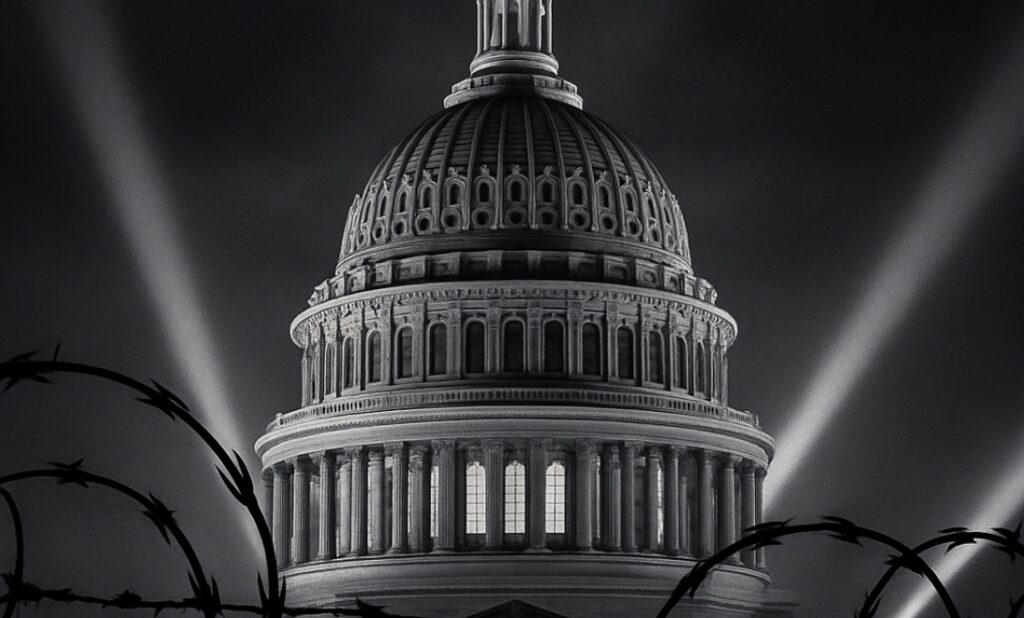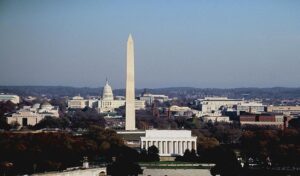
The Warning Signs Add Up
The word martial law carries heavy weight in American history. While no formal declaration has been made, the pattern of Donald Trump’s recent actions suggests he may be laying the groundwork for something disturbingly close. From threatening to use military force in U.S. cities, to funneling unprecedented sums into immigration enforcement, the signs are there for anyone paying attention.
A recent Ground News report detailed Trump’s threat to revoke funding for a critical bridge while also floating the idea of sending troops into Baltimore. This, combined with his comments about “fixing” Chicago the way he claims to have “fixed” Washington, paints a picture of a president testing how far he can push his authority.
Martial Law and National Guard on City Streets
The deployment of the National Guard in Washington, D.C. has escalated beyond temporary support. Troops are now authorized to carry weapons and act in law enforcement capacities. That move, justified by little more than Trump’s own insistence, runs directly against the long-standing principle of the Posse Comitatus Act, which restricts the military’s role in civilian policing.
Once soldiers begin patrolling American neighborhoods with arrest powers, the line between public safety and martial law grows dangerously thin. Trump’s suggestion that these deployments could extend indefinitely only heightens concern.
FEMA Powers and Emergency Declarations

Trump has also leaned heavily on FEMA authority to justify his control in the name of national emergencies. By labeling situations as crises, he gains broad powers to deploy resources, troops, and surveillance measures. This tactic allows him to bypass traditional checks and balances.
The problem is that when emergency declarations become the norm rather than the exception, the public begins to live under conditions that mirror martial law without ever hearing those exact words.
The Explosive Growth of ICE’s Budget
Immigration and Customs Enforcement (ICE) has seen its annual budget balloon from $8.7 billion to nearly $27.7 billion under Trump’s signature domestic policy initiatives. That puts ICE funding on par with, or even larger than, the entire military budgets of many nations.
For perspective, Canada spends around $29 billion annually on its military. ICE now sits just below that level. Such massive funding expands detention facilities, ramps up raids, and adds thousands of agents. This isn’t just immigration enforcement — it’s the building of a paramilitary force with resources surpassing most foreign armies.
Control by Infrastructure and Intimidation

Trump has repeatedly tied military presence to federal funding threats. In Baltimore, for example, infrastructure dollars were dangled alongside the suggestion of troop deployments. This linkage of public services to political compliance sets a dangerous precedent. When a president uses both the purse strings and the military as levers of control, the outcome looks less like democracy and more like strong-man rule.
What Comes Next?
None of this guarantees a formal declaration of martial law. But when you combine armed National Guard troops in the capital, emergency powers exercised through FEMA, an ICE budget larger than many militaries, and threats of troop deployments tied to federal funds, the direction is unmistakable.
Each move, taken alone, might be explained away as temporary or situational. Together, they look like a strategy: slow-rolling America toward martial law conditions without ever having to announce it outright.
Update: The Tragic Killing of Charlie Kirk Raises New Alarms on Martial Law
Since this article’s original publication, the shocking and tragic killing of conservative commentator Charlie Kirk has sent shockwaves through the political landscape. While authorities are still investigating the circumstances, the aftermath is already intensifying fears of political violence spiraling into something much darker.
The question must now be asked with even greater urgency: is martial law in America coming soon? As tensions rise, protests ignite, and calls for order grow louder, it’s not hard to imagine a scenario where martial law is no longer just a political talking point — but a real and imminent policy move.
If national unrest escalates in the wake of Kirk’s death, and partisan blame continues to fuel online and on-the-ground hostility, the United States could be pushed to the brink. In that volatile environment, the idea of a federal response involving the military may shift from improbable to inevitable. The slow creep toward authoritarianism this article warned of may have just accelerated.
A Future Worth Questioning
Citizens must decide whether these actions represent legitimate governance or a dangerous drift into authoritarian control. Democracies aren’t lost overnight — they erode step by step. With FEMA powers stretched, ICE militarized, and the National Guard turned into a domestic police force, the warning lights are flashing.
The question is whether people will recognize these signals and speak out, or whether America will wake up one morning to discover martial law already in effect, not by declaration, but by practice.





